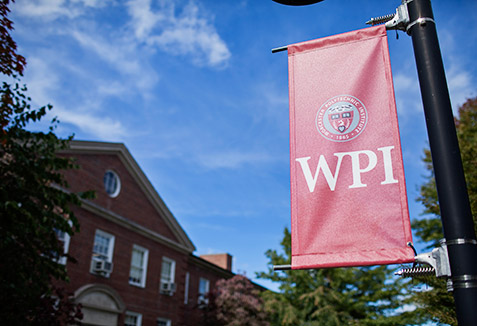WPI students huddled together around tables strewn with copper tape, cardstock, scissors, coin cell batteries, vibration motors, nail clippers, and paperclips. Some students picked up and examined the items. Others opened their laptops and studied a diagram.
It was a training session for WPI’s Engineering Ambassadors, a group of 42 undergrads who work with the Office of Pre-Collegiate Outreach Programs to get young students excited about STEM. On this day, the trainees were putting together a wristband that could send Morse code signals using motorized vibrations. It’s one of the projects featured in the recent NOVA docuseries Building Stuff and the ambassadors were making sure they could complete it themselves before teaching it to younger students.
The student ambassadors got to work with a hum of animated chatter. Individual voices periodically stood out from the rest:

Assembling the mechanical wristband
“Actually, a paperclip would be really nice.”
“I’m so confused.”
“We got it!!”
One student smiled while raising an arm encircled by a vibrating wristband.
Ambassadors as troubleshooters
Last summer staff from GBH, Boston’s PBS affiliate and producer of the popular science show NOVA, recruited the Engineering Ambassadors to troubleshoot instructions for the wristband and two other hands-on projects in an outreach toolkit that supplements the Building Stuff docuseries.
“The Engineering Ambassadors’ mission goes right along with what GBH was trying to do with this documentary, which is getting younger folks interested in STEM,” says James Guaragna, associate director of WPI’s pre-collegiate outreach programs.
NOVA’s outreach kit helps classroom teachers and community groups further demystify the engineering topics covered in the docuseries by getting viewers to learn by doing. Each project in the booklet corresponds to one of the series’ episodes: “Boost It!,” “Reach It!,” and “Change It!”
Seven WPI ambassadors volunteered to try out the projects and offer input to help GBH staff clarify the toolkit’s written instructions.
“Their feedback was extremely helpful and informative in making sure that the engineering activities had instructions and diagrams that were easy to follow for students and would keep students engaged,” says Ralph Bouquet, NOVA’s director of education and outreach.
Mechanical engineering major Jorge Saa ’26 tested the wristband project, which was inspired by a section of the documentary about haptics.
“When we looked at the first diagram that we were given, we were confused. The instructions were a bit broad, but we made it work,” Saa says. “Then we met with the GBH people who designed the project and gave them a few recommendations on what information to include.”




